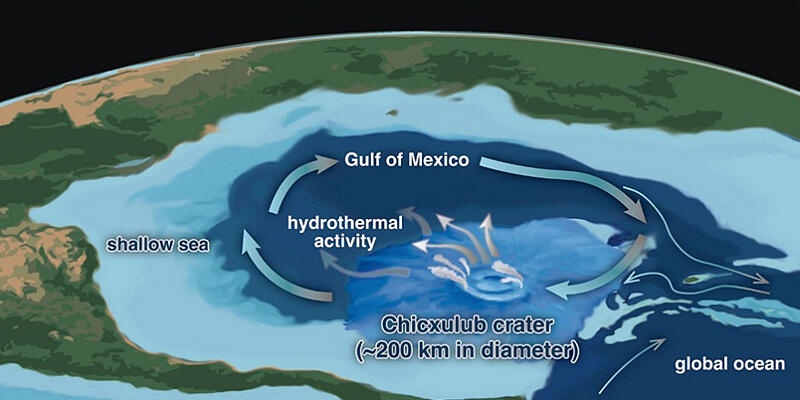About 66 million years ago, an asteroid struck off the Yucatán Peninsula in Mexico, causing the extinction of approximately 70% of marine organisms. Research on sediments from the impact crater (results from IODP research expeditions) had shown that ecosystem recovery at the impact site took less than tens of thousands of years—unexpectedly fast—but the reason remained unknown.
An international research group led by Assistant Professor Honami Sato from the Faculty of Science at Kyushu University and Associate Professor Akira Ishikawa from the School of Science at the Institute of Science Tokyo has revealed that the Gulf of Mexico formed a semi-enclosed marine environment for at least 700,000 years after the impact and was influenced by hydrothermal activity generated directly below the crater. This information came from fossil beds and osmium isotope ratios in strata from over approximately 3 million years after the asteroid impact was recorded in the sediment of the Gulf of Mexico. The group further demonstrated that nutrients continuously supplied to the Gulf of Mexico through this hydrothermal activity likely played a crucial role in the rapid ecosystem recovery rate and significant transitions in fossil communities at the impact site. These findings were published in Nature Communications.

(Photo credit: Sato, H., Kyushu Univ.)
Provided by Kyushu University
In this study, the researchers analyzed drill core samples from the Chicxulub crater and sediments deposited over approximately 3 million years after the impact from eastern Mexico. They obtained high-resolution sedimentation ages using planktic foraminiferal biostratigraphy and examined detailed records of osmium isotope ratio fluctuations. The results revealed that it took about 700,000 years for the low osmium isotope ratio (187/188 = 0.2) recorded in impact-derived sediments to return to pre-impact values (0.4).
This timeframe differs significantly from the period (approximately 200,000 years) reported from open ocean areas more than 5,000 kilometers away from the impact site. This suggests that asteroid material with low osmium isotope ratios, deposited below and around the crater, was continuously supplied only to the Gulf of Mexico.
Evidence of elemental migration due to submarine hydrothermal activity caused by the asteroid impact has been recognized across a very wide range (5-6 kilometers below the seafloor, approximately 14×10^15 cubic kilometers) beneath the Chicxulub crater sea floor. Heavy metal elements such as manganese and lead contained in rocks dissolve slowly when they react with hydrothermal fluids, and when these upward-moving hydrothermal fluids are then cooled by seawater, precipitates are incorporated into the sediments. The researchers identified hydrothermal fluids as the source of the low osmium isotope ratio by observing characteristic concentrations of manganese and lead in post-impact sediments within the crater, which gradually decreased over 700,000 years. These results indicate that a semi-enclosed marine environment formed in the Gulf of Mexico after the impact and was strongly influenced by hydrothermal fluids from beneath the crater for 700,000 years.
After the asteroid impact, fossils of calcareous nannoplankton (indicators of basic biological production) and planktonic foraminifera (indicators of marine environment) rapidly increased in the crater's marine area. Around the 700,000-year mark, when hydrothermal activity influence ended, there was a notable transition from fossil communities indicating eutrophic environments to those indicating oligotrophic environments. This suggests that the unusually rapid ecosystem recovery at the impact site may have been caused by the nutrient-rich marine environment created by hydrothermal activity beneath the crater. Indeed, phosphorus concentrations were recorded simultaneously with manganese and lead concentrations, suggesting that the abundant supply of nutrients such as phosphates in the hydrothermal fluids had a significant impact on both the rapid ecosystem recovery and community changes.
Sato commented: "After the asteroid impact, the Gulf of Mexico formed a unique marine environment due to continuous hydrothermal activity, recording an ecosystem recovery process completely different from open ocean areas. I would be delighted if people could understand that the biological extinction and evolution processes associated with large-scale impact events become visible not only through paleontology and oceanography but also through geochemistry."
Journal Information
Publication: Nature Communications
Title: Prolonged 187Os/188Os excursion implies hydrothermal influence after the Chicxulub impact in the Gulf of Mexico
DOI: 10.1038/s41467-025-58112-x
This article has been translated by JST with permission from The Science News Ltd. (https://sci-news.co.jp/). Unauthorized reproduction of the article and photographs is prohibited.




